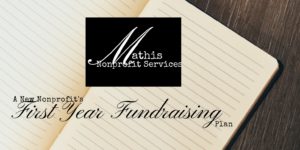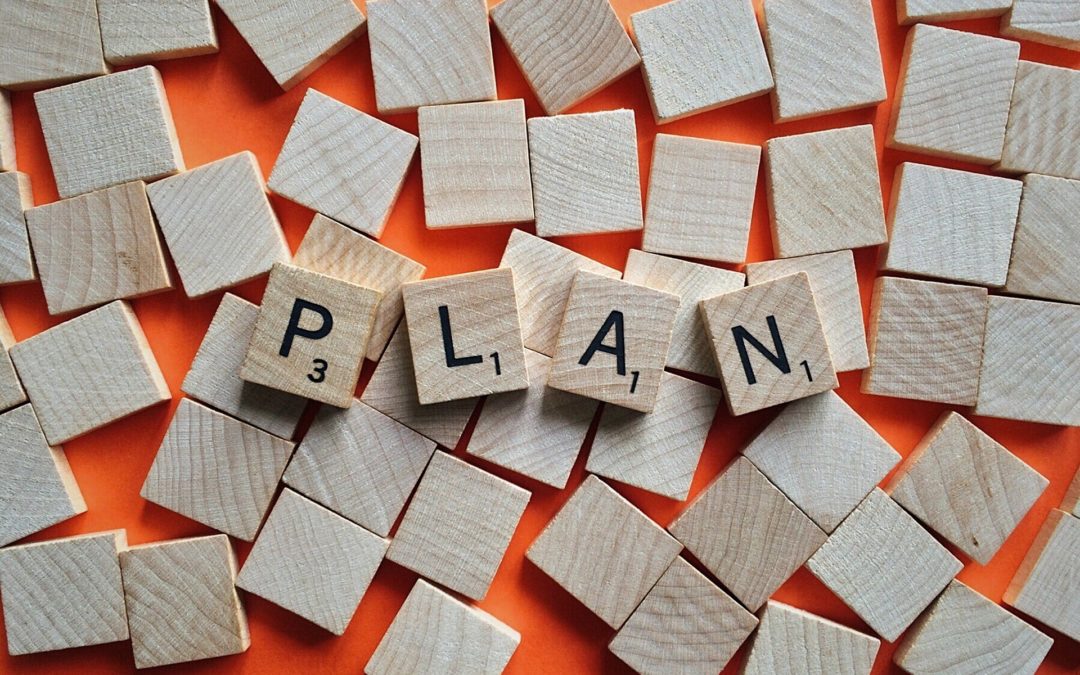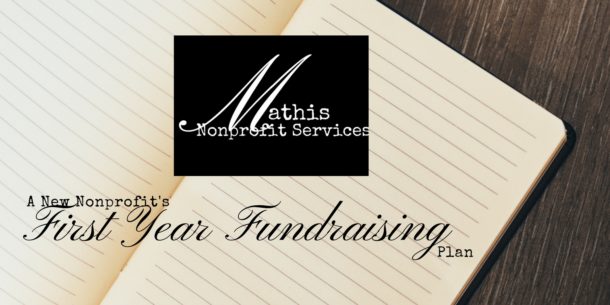A Fundraising Plan is a roadmap to get from where you are now to where you want to be this time next year. There are a lot of fundraising plans out there but they are all cumbersome for a small nonprofit. These plans require a lot of work, are complicated and, really, most of the plan isn’t helpful if you are just starting out. When you are just starting out, keep your fundraising simple. I put together a plan that should get you through the first five years. You should outgrow this plan and need something more robust after five years. Here are the 5 Steps needed to put together the First Year Fundraising Plan. Step 1: Current Assessment Where are you right now? How many donors do you have? What is the amount that has been given (in the current year)? Have you done any fundraising? What worked? Why? What didn’t? Why? Step 2: Identify Your Assets Think about Board members with connections. Supporters with connections. Do you have great name recognition? What does your organization have going for it that you can leverage in your fundraising efforts? Step 3: Set Targets, Identify Strategies, Set Goals for Your Strategies, and Determine Action Steps for Each Goal Set Targets Targets are the overall goals of your plan. Think big picture here. Targets should always include Fundraising target (dollar amount), Existing Donor target (how many will you retain?), and New Donor target (number increase). Examples of Targets: Fundraising– Our fundraising target for the FY 2018-2019 is $5,000. Existing Donors– We will send out letters in July and November to nurture Donor relationships. These letters will contain an update on the impact we hare having on our clients and a soft ask for donations. New Donors– We will increase our new Donors by 100 for the FY 20118-2019. Identify your Strategies Strategies should support your Targets. What income sources do you want to pursue in the coming year or two? (Fundraising target) What strategies will you use to communicate with your Existing Donors (Existing Donor target)? How will you bring in new donors (New Donor target)? You can write them all down and then select 3-4 to focus on in the coming year to make it manageable. Typical first five year income sources are: donations, DIY fundraising, events, grants, (if applicable: Sales or Memberships).
Terminology: Donations- money was given by existing and new donors and meeting IRS conditions. DIY fundraising or Grassroots fundraising is when an individual or group raises funds for your group. It is usually an event (bake sale, yard sale, or golf tournament) that benefits your organization. Events- usually an activity that involves the public. Grants- written requests to Foundations and other large philanthropic organizations. Sales- your program or organization may sell items or have a fee for services. Not applicable to all nonprofits. Memberships- some nonprofits sell memberships to their services (think Museum as an example). Not applicable to all nonprofits.
Set Goals for Your Strategies These goals are different from your targets. They are specific to the 3-4 Strategies you decided to focus on in Step 4. Not all goals have to have an income associated with them in the first year. For example, you may want to start positioning yourself for grants next year. You would want to make grants a focus and your goals would be things you need to be able to apply. One goal may be to set up your program with grants in mind. (I have a program creation bonus here.) For measurable goals: How many new donors do you want to increase by? How many fundraising dollars do you want to bring in? How will you provide stewardship to existing donors? Make these goals SMART. Examples of Goals for Strategies: Donations- Existing Donor– Raise $2,000 from donations. New Donor- We will increase our new Donors by 100 for the FY 2018-2019. DIY fundraising or Grassroots fundraising – Set up DIY fundraising and approve 2 DIY fundraisers during the year. Raise $500. Events- Create one signature event and hold it in the Spring. Grants- Begin recording outcomes and client stories to prepare for grants in the next three years. (If applies) Sales- Provide services to 10 new clients, raising $1,000 in revenue. Memberships- Gain 20 new memberships in the FY 2018-2019. Determine Your Action Steps for Each Strategy Goal Do you want to be ready for grants? What do you need to do this year to be ready? Do you want to send donor communications to retain existing donors? What action steps do you need to do to get to your goal? Include a budget in this section. Step 3: Final Product Sample: Target 1: Fundraising: $5,000 Strategy 1: Receive $2,000 total from two Donor letters. Action Step 1: We will send out letters in July and November to nurture Donor relationships. These letters will contain an update on the impact we hare having on our clients and a soft ask for donations. Strategy 2: Raise $1,000 total from DIY Events over the year. Action Step 1: Design a webpage with approved ideas of DIY fundraising. A downloadable idea sheet will be created as a Lead Magnet to capture new donor contact information. Action Step 2: Post once a month on social media that we want DIY fundraisiers and link to a DIY page. Action Step 3: Designate one person to monitor, record, and be a liaisons to individuals and groups wanting to participate. This person will record contacts, DIY project, and dollar amount raised by each project. Strategy 3: Raise $2,000 from a Signature Event. Action Step 1: Create a Committee for this purpose. Action Step 2: Determine the type of event. Action Step 3: Plan. Action Step 4: Execute. Action Step 5: Right, Wrong, Missing, Confusing Report for the event. Strategy 4: Begin recording outcomes and client stories to prepare for grants in the next three years. Action Step 1: Create and Assign a person to create a spreadsheet for each month of the fiscal year. This spreasheet will include beginning client numbers, ending client numbers, and waitlist numbers. Action Step 2: Assign a person to begin collecting testimonials about out services. Decide on a system for collecting and storing these items. Target 2: Existing Donors: Increase Communication Strategy 1: Letters Action Step 1: We will send out letters in July and November to nurture Donor relationships. These letters will contain an update on the impact we hare having on our clients and a soft ask for donations. Target 3: New Donors: Increase our new Donors by 100 for the FY 2018-2019. Strategy 1: Letter Writing Campaign Action Step 1: We will ask Board members to bring 5 names and contact information of people they think will be interested in donating to our cause. Action Step 2: We will capture any contact information we can with all fundraising activities. Step 4: Monitor Plan How will you monitor your progress? What milestones will you need? Combine a calendar and Step 6 here. Step 5: Refine Plan As you go through your year, make sure you add a Right, Wrong, Missing, and Confusing report for your activities. This report will help you refine your activities the following year. How will you revisit your plan to make changes? What system will you have for those changes? There it is, 5 Steps to a Fundraising Plan. I have a gift for you! It’s a First Year Fundraising Plan template. It follows the steps and is a word document so you can fill it in and have a Fundraising Plan in a few hours. 



 Most nonprofit leaders lay awake at night trying to figure out how to fund their mission.
Hi! I'm Alesha.
I teach sustainable fundraising in a way that they can take action today so they can serve their clients.
I can help you move from just getting started funding your new nonprofit to gaining confidence in your fundraising and building relationships to knowing what works for your organization and looking at the infinite game when it comes to funding. I’ve worked with nonprofit Founders and written the book I HAVE MY 501(C)3! NOW WHAT?!? Your Blueprint to Starting Your Nonprofit Without Being the Sole Funder that lays the foundations for funding in a new nonprofit.
I’ve worked in Development (Fundraising) Departments in large organizations and I know the no cost, low-cost methods they use to bring in funding. I bring those sound strategies to the nonprofits I serve.
Most nonprofit leaders lay awake at night trying to figure out how to fund their mission.
Hi! I'm Alesha.
I teach sustainable fundraising in a way that they can take action today so they can serve their clients.
I can help you move from just getting started funding your new nonprofit to gaining confidence in your fundraising and building relationships to knowing what works for your organization and looking at the infinite game when it comes to funding. I’ve worked with nonprofit Founders and written the book I HAVE MY 501(C)3! NOW WHAT?!? Your Blueprint to Starting Your Nonprofit Without Being the Sole Funder that lays the foundations for funding in a new nonprofit.
I’ve worked in Development (Fundraising) Departments in large organizations and I know the no cost, low-cost methods they use to bring in funding. I bring those sound strategies to the nonprofits I serve.